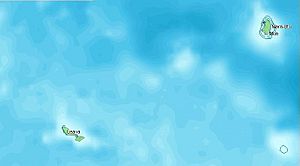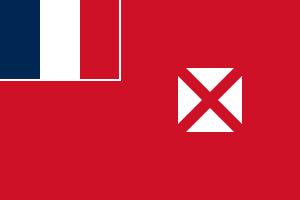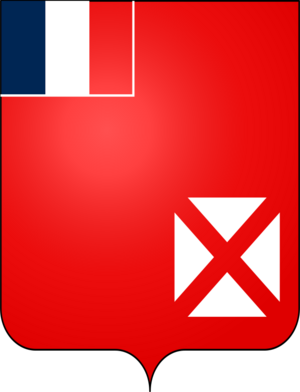Wallis and Futuna facts for kids
Wallis and Futuna, officially known as the Territory of Wallis and Futuna Islands (in French: Wallis et Futuna), is a group of three volcanic tropical islands. These islands are Wallis (also called Uvea), Futuna, and Alofi. They are surrounded by beautiful reefs.
You can find Wallis and Futuna in the South Pacific Ocean. They are located between the countries of Fiji and Samoa. One of the islands, Wallis, is named after a Cornish explorer named Samuel Wallis. He explored this area a long time ago.
Contents
Exploring the Islands of Wallis and Futuna
Wallis and Futuna is a special place made up of three main islands and many smaller islets. These islands were formed by volcanoes, which means they have rich, fertile soil. The warm, tropical climate makes them perfect for growing many plants.
Wallis Island: The Main Island
Wallis Island, also known as Uvea, is the most populated island. It is home to the capital city, Mata-Utu. This island has a large lagoon surrounded by a coral reef. The lagoon is a safe place for boats and is full of marine life.
Life on Wallis Island
Most people on Wallis Island live in small villages along the coast. The island has a mix of traditional Polynesian culture and French influences. This is because Wallis and Futuna is a territory of France.
Futuna and Alofi: The Hoorn Islands
Futuna and Alofi are two other important islands in the group. They are sometimes called the Hoorn Islands. Futuna is where most people live, while Alofi is mostly uninhabited. People from Futuna often visit Alofi to grow crops.
Unique Culture of Futuna
Futuna has its own distinct culture and language, different from Wallis. The people here are very proud of their traditions. They live a simpler, more traditional lifestyle compared to Wallis.
History of Wallis and Futuna
The islands of Wallis and Futuna have a long and interesting history. Polynesian people first settled these islands thousands of years ago. They developed unique cultures and kingdoms.
Early European Contact
The first European to visit these islands was Jacob Le Maire in 1616. He was a Dutch explorer. Later, in 1767, the British explorer Samuel Wallis arrived. He named Wallis Island after himself.
Becoming a French Territory
In the 19th century, French missionaries came to the islands. They introduced Christianity. In 1887, the local kings and queens asked France for protection. The islands officially became a French territory in 1961.
Government and Politics
Wallis and Futuna is an overseas territory of France. This means it is part of France but has its own special rules. The people here are French citizens.
Local Leadership
The islands have a unique system of government. There is a high administrator appointed by France. But there are also three traditional kings. Each king rules one of the main islands or island groups. These kings work with the French administration.
How Laws Are Made
The people of Wallis and Futuna elect representatives to a territorial assembly. This assembly makes local laws. They also send a representative to the French Parliament in Paris. This allows their voices to be heard in France.
Economy and Daily Life
The economy of Wallis and Futuna is quite small. It mainly relies on farming, fishing, and money sent from relatives living overseas.
Farming and Fishing
Most families grow their own food, like yams, taro, and bananas. Fishing is also very important for food and income. People catch fish from the ocean and the lagoons.
Tourism and Future
Tourism is not a big industry yet, but the islands have beautiful beaches and reefs. There is potential for more visitors in the future. The people of Wallis and Futuna work to keep their traditions alive while also looking towards the future.
Images for kids
-
Drawing of Wallis Island by captain Samuel Wallis in 1767
-
Aerial view of Wallis Island (Uvea)
See also
 In Spanish: Wallis y Futuna para niños
In Spanish: Wallis y Futuna para niños








